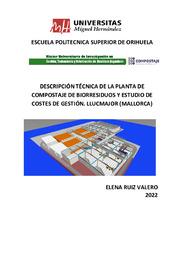Por favor, use este identificador para citar o enlazar este ítem:
https://hdl.handle.net/11000/28512Descripción técnica de la planta de compostaje de biorresiduos y estudio de costes de gestión. Llucmajor (Mallorca)
| Título : Descripción técnica de la planta de compostaje de biorresiduos y estudio de costes de gestión. Llucmajor (Mallorca) |
| Autor : Ruiz Valero, Elena |
| Tutor: Paredes Gil, Concepción Martínez Redondo, Alberto |
| Editor : Universidad Miguel Hernández de Elche |
| Departamento: Departamentos de la UMH::Agroquímica y Medio Ambiente |
| Fecha de publicación: 2022-09 |
| URI : https://hdl.handle.net/11000/28512 |
| Resumen : Proyecto de una PLANTA DE COMPOSTAJE para los BIORRESIDUOS DE LLUCMAJOR EN MALLORCA, y su estudio costes de funcionamiento. Para realizar el diseño y concepción de esta instalación industrial de tratamiento de residuos orgánicos mediante compostaje se realizó análisis de la capacidad para alcanzar los niveles o condiciones óptimos de estos parámetros según los condicionantes del proyecto: tipo y cantidades de residuo/s, disponibilidad de material estructurante y complementario, tiempo de proceso mínimo necesario, superficie disponible, condiciones meteorológicas de la zona, etc. De este análisis se obtiene un primer planteamiento de cuál es la combinación de sistemas de compostaje más adecuados para el proyecto y cuál sería el protocolo de trabajo o manejo correspondiente. Así para poder adaptarse a los incrementos de entradas de biorresiduos que se produce durante los meses de mayor afluencia turística a la isla, la instalación debe tener una capacidad de tratamiento de la fracción orgánica de la recogida separada (en adelante FORM) de 21.000 t/año (Residuos biodegradables de cocinas y restaurantes 20 01 08 y Residuos de mercados 20 03 02) y 6.030,5 t/año de estructurante, en este caso los restos de podas) (Residuos biodegradables de parques y jardines 20 02 01). Se establece para el proceso de compostaje el sistema de túneles cerrados ventilados y estáticos para un tiempo de permanencia de 2 + 2 semanas, lo que implica un trasvase de material de un túnel a otro al cabo de las primeras 2 semanas para llegar a cumplir los condicionantes óptimos establecidos. La capacidad de monitorización en continuo de diferentes parámetros clave de proceso y de control sobre ellos (temperatura, nivel de oxígeno, humedad) da a este sistema la capacidad de optimizar la actividad biológica degradativa de los microorganismos. Se plantea que, tras la primera fase de compostaje en túneles, se pase a una maduración en un sistema dinámico que aporte al material las ventajas para el proceso que no tienen los sistemas estáticos. Además, para eliminar la presencia de impropios se estable un pretratamiento. Para realizar el estudio de costes se realiza un dimensionamiento de las operaciones directas de producción, internas y externas, de los servicios generales, limpieza, mantenimiento y estudian los consumos eléctricos, de combustible, agua y de depuración de agua, para el cálculo del modelo económico para el personal, el mantenimiento los consumos y los servicios externos subcontratados. Finalmente se diferencian entre costes fijos y variables y obteniendo un total de costes de 2.503.410,81 €/año, y ascendiendo el canon a 171,65 €/t. Project of a COMPOSTING PLANT for the BIORESIDUOS DE LLUCMAJOR IN MALLORCA, and its operating costs study. In order to carry out the design and conception of this industrial facility for the treatment of organic waste by composting, an analysis of the capacity to reach the optimum levels or conditions of these parameters was carried out according to the conditioning factors of the project: type and quantities of waste, availability of structuring and complementary material, minimum process time required, available surface, meteorological conditions of the area, ... From this analysis a first approach is obtained of which is the combination of composting systems most suitable for the project and which would be the corresponding work or management protocol. Thus, in order to be able to adapt to the increase in the amount of biowaste that enters the island during the months of greatest tourist influx, the facility must have a treatment capacity of the organic fraction of the separate collection (hereinafter FORM) of 21,000 t/year (biodegradable waste from kitchens and restaurants 20 01 08 and waste from markets 20 03 02) and 6,030.5 t/year of structural waste, in this case the remains of pruning) (biodegradable waste from parks and gardens 20 02 01). For the composting process, the system of closed ventilated and static tunnels is established for a permanence time of 2 + 2 weeks, which implies a transfer of material from one tunnel to another after the first 2 weeks in order to comply with the optimum conditions established. The ability to continuously monitor and control different key process parameters (temperature, oxygen level, humidity) gives this system the ability to optimize the rate of degradative biological activity of the microorganisms. it is proposed that, after the first phase of fermentation in tunnels, maturation in a dynamic system should be carried out in order to provide the material with the advantages for the process that static systems do not have. In addition, in order to eliminate the presence of undesirable substances, a pretreatment is established. To carry out the cost study, a dimensioning of the direct operations of production, internal and external, of the general services, cleaning, maintenance and study the electrical, fuel, water and water purification consumptions, for the calculation of the economic model for the personnel, the maintenance, the consumptions and the subcontracted external services. Finally, we differentiate between fixed and variable costs and obtain a total cost of 2,503,410.81 €/year, and the fee amounts to 171.65 €/ton. |
| Palabras clave/Materias: Compostaje Residuos orgánicos |
| Área de conocimiento : CDU: Ciencias aplicadas: Agricultura. Silvicultura. Zootecnia. Caza. Pesca: Agricultura. Agronomía. Maquinaria agrícola. Suelos. Edafología agrícola |
| Tipo documento : application/pdf |
| Derechos de acceso: info:eu-repo/semantics/openAccess |
| Aparece en las colecciones: TFM - M.U Gestión, Tratamiento y Valorización de Residuos Orgánicos. |
 La licencia se describe como: Atribución-NonComercial-NoDerivada 4.0 Internacional.
La licencia se describe como: Atribución-NonComercial-NoDerivada 4.0 Internacional.
.png)
